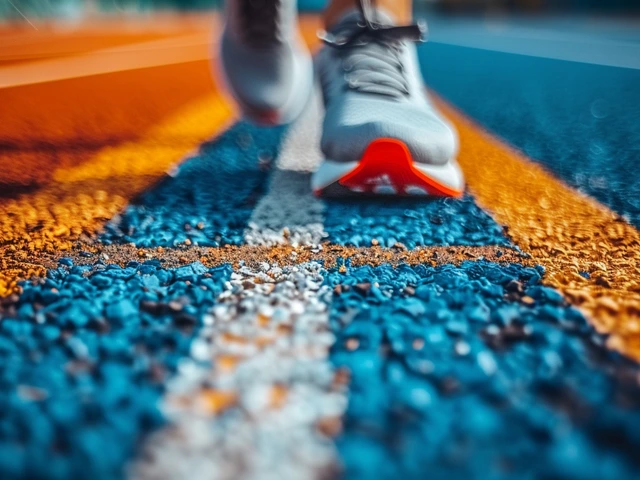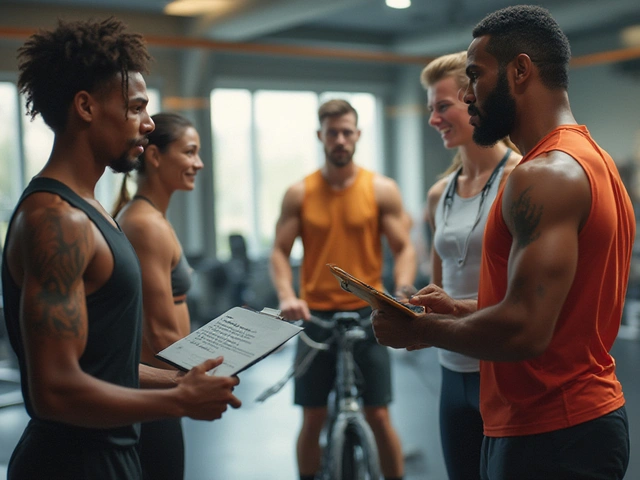Ever wondered why top athletes swear by sports massage? It’s not about pampering—it’s about staying in the game and out of the doctor’s office. Sports massage targets problem muscles, boosts blood flow, and heads off injuries before they turn into a nightmare. Even weekend warriors and casual runners can benefit, not just the pros.
You don’t have to wait until something hurts to book a session. Tight shoulders after a desk job? Sore legs after a hard workout? These little aches are warning lights for bigger problems down the road. Regular sports massage helps spot these issues early, so you can fix them before they bench you. Plus, it speeds up recovery and keeps muscles flexible, which means fewer strains and less downtime.
- Why Sports Massage Is Different
- How It Actually Prevents Injuries
- Spotting the Early Warning Signs
- When and How Often Should You Get One?
- What to Expect During a Session
- Pro Tips and Common Myths
Why Sports Massage Is Different
Not all massages are created equal. Sports massage is totally different from a relaxing spa treatment. It’s a focused, hands-on approach that zeroes in on muscles, tendons, and connective tissue used in your specific sport or regular workouts. Where regular massages help you unwind, sports massage is all about getting your body ready to move and recover faster afterwards.
One thing that sets sports massage apart is how it adapts to your needs. A runner gets help with tight hamstrings, while a tennis player might need extra work on their shoulder. Therapists use techniques like deep tissue work and stretching to break up scar tissue, improve circulation, and keep muscle fibers moving the way they should. This isn’t random kneading—it’s science-backed, and it’s targeted.
Here’s what really stands out about sports massage:
- Goal-driven: It’s not just about feeling good. It’s meant to stop injuries, boost performance, and get you ready for your next session.
- Active techniques: Includes methods like trigger point therapy, cross-fiber friction, and assisted stretching you won’t find in a typical relaxation massage.
- Personalized: The focus changes based on your training, injuries, and goals. No two sessions are exactly the same.
Fast fact: Research from the American College of Sports Medicine found that sports massage helps reduce delayed onset muscle soreness (DOMS) by up to 30%. Less soreness means fewer missed workouts and better progress.
If you just want to relax, there are plenty of massages for that. But if you want to keep your body moving and dodge sidelining injuries, sports massage really is in a league of its own.
How It Actually Prevents Injuries
There’s a real science behind why sports massage keeps you off the sidelines. The main thing? It helps muscles work better and stay loose, instead of tightening up and becoming injury-prone. By working out those stubborn knots and moving blood around, it pushes fresh oxygen and nutrients to sore spots—helping them heal quicker. Less stiffness means less chance of those small tears in muscles and ligaments that can turn into bigger problems.
One big deal is how sports massage helps flush out waste products like lactic acid. When these sit in your muscles after a workout, you end up stiff and sore—perfect conditions for things like strains or cramps. Breaking up scar tissue from old injuries is another win. Instead of weak spots, you get stronger, more flexible tissue. That’s a huge factor in injury prevention no matter your sport.
Check out some simple numbers:
| Benefit | Improvement (%) |
|---|---|
| Muscle flexibility | Up to 30% |
| Circulation increase | 20-25% |
| Recovery time | Reduced by 50% |
Direct pressure from massage helps the nervous system relax, too, making you less likely to have your muscles freak out and pull awkwardly. That’s why so many top teams have therapists on speed dial—catching tight spots before they become strains, pulls, or full-on tears. The real magic? Sports massage doesn’t just treat pain, it prevents it.
Still not convinced? Here’s what happens when you make sports massage part of your regular game plan:
- Reduces muscle tightness and imbalance
- Boosts range of motion so you move better
- Lowers the risk of overuse injuries
- Speeds up recovery so you’re ready for action sooner
If you’ve ever tweaked a muscle because it was too tight or been forced to skip a game with a pulled hammy, you know prevention beats treatment every time. Sports massage helps spot problems early—way before they pull you off the field.
Spotting the Early Warning Signs
If you’ve ever ignored a random ache and pushed through, you’re not alone. But here’s the deal: most serious sports injuries start with a little “something’s not right” feeling. Spotting these signals early can save you months on the sidelines.
Common warning signs might show up in weird ways. You might notice a certain muscle feels tighter than usual even when you haven’t done anything out of the ordinary, or maybe your joints click or pop more than usual. These aren’t normal. Here’s what to watch for:
- Stiffness that won’t go away with basic stretching
- Muscle soreness lasting longer than a couple of days
- Twinges or sharp discomfort during usual movements
- Reduced range of motion (maybe you can’t twist or reach like before)
- Unusual swelling or mild bruising
Even the pros are watching for these red flags. According to Dr. Michael Clark, CEO of the National Academy of Sports Medicine,
“Catching discomfort early and taking action drops the risk of major injuries more than half. Don’t wait for serious pain—your body always sends the first hint.”
Data doesn’t lie. A study published in the British Journal of Sports Medicine found that athletes who reported their warning signs to therapists and received early sports massage treatment had a 45% lower risk of injury-related time lost compared to those who delayed care.
| Warning Sign Ignored | % of Minor Issues Becoming Severe Injuries |
|---|---|
| Muscle Stiffness | 37% |
| Lingering Soreness | 41% |
| Twinges/Pain | 58% |
The bottom line—don’t ignore the little stuff. If you feel a tweak or some swelling, consider it a message from your body. Catch it early with the help of a sports massage, and you’ll avoid a world of hurt later. Your future self will thank you.

When and How Often Should You Get One?
So, how often do you really need a sports massage? There’s no one-size-fits-all answer. Your schedule should match your activity level, your training goals, and how your body feels. Here’s a quick look at what different folks actually do:
| Activity Level | Recommended Frequency | Purpose |
|---|---|---|
| Elite athlete (training daily) | Once to twice a week | Performance boost, injury prevention |
| Regular exerciser (3–5 times a week) | Every 2–4 weeks | Sprain prevention, faster recovery |
| Weekend warrior / casual | Monthly or as needed | Muscle tension, early injury signs |
| Healing from injury | As recommended by physio | Targeted rehab, gentle recovery |
If you’re upping your training—think race season, long gym sessions, or tournaments—it’s smart to bump up massage frequency. Life is unpredictable, so listen to your body: sore muscles, less flexibility, poor sleep, or slower recovery after workouts are hints that you could use a session.
Don’t wait until you’re already hurting. Pre-event massages (about 24-48 hours before) help you warm up and spot last-minute tight spots. On the flip side, post-event massages (within a day or two after hard efforts) help cut down on soreness and speed up your bounce-back.
- If you’ve never had a sports massage, start with one a month and adjust from there.
- Book more often during heavy training, after a race, or when you notice stiffness or pain.
- Chat with your therapist—they’ll help build a plan that works for your schedule and goals.
Bottom line: it’s all about regular check-ins. Consistency wins out over cramming all your care into a single, last-ditch session when you’re feeling broken.
What to Expect During a Session
Walking into your first sports massage might feel a little nerve-wracking if you don't know what’s coming. No candles or peaceful ocean sounds here—it’s all about results. Sessions are usually pretty straightforward, focused on your needs and your activity level.
The massage therapist will chat with you first to ask about any injuries, pain, or training changes. They’ll want to know if you’re prepping for a big race or just finished one because the approach can be totally different. For example, a pre-event massage targets freshening up muscles and is a lot lighter, while a post-event or maintenance massage digs deeper to break up tough knots and help you recover.
Here’s the usual flow:
- Assessment – Quick talk about your health, activity, and any aches.
- Target Area Focus – Work centers on the body parts you use most or that feel tight.
- Techniques – Expect a mix of deep tissue work, stretching, kneading, compression, and even some trigger point therapy. It might feel intense at times, but it shouldn’t be agony. Always speak up if something is too much.
- Feedback – The therapist might ask you to move a bit during the massage, check your range of motion, or rate your pain.
- Wrap Up – You’ll get tips before you leave, like ice or heat suggestions, stretches, or when to come back next.
A lot of people want to know how long these sessions last. It usually ranges from 30 to 90 minutes, depending on what you need. Sometimes, just 20 minutes on specific muscle groups can be solid for people who don’t need full-body work. Costs vary too—expect $60 to $130 for a one-hour sports massage in the U.S. as of 2025.
Check out this breakdown:
| Session Type | Typical Duration | Avg. Cost (USD) |
|---|---|---|
| Pre-event | 15–30 min | $30–$60 |
| Post-event | 20–60 min | $40–$100 |
| Maintenance | 60–90 min | $80–$130 |
When you head in, wear loose, comfy clothes, or workout gear. And yes, hydration actually matters—drink water before and after, as it helps muscles flush out junk released during the massage. If you feel sore the next day, don’t freak out. That’s normal, especially after deep work. Try some light movement or easy stretching to help your body bounce back even faster.
Pro Tips and Common Myths
There’s a lot of buzz about sports massage, and some of it can be pretty misleading. Let’s get real about what actually works, and what’s just gym talk.
- Don’t wait until you’re injured. Regular sports massage helps keep muscles supple, improves flexibility, and stops those little aches from turning into big ones. According to a 2023 report from the National Academy of Sports Medicine, athletes who got a sports massage at least every two weeks had 35% fewer minor soft tissue injuries. Even if you aren’t a pro, sticking to a schedule beats using massage as a last resort.
- It’s not supposed to be agony. You don’t need to grip the table and sweat through the pain. A good sports massage can include deep tissue work, but the pressure should always be manageable. If it hurts too much, the therapist could actually make things worse instead of helping.
- Hydrate, but skip that giant bottle right before your appointment. Staying hydrated helps flush out waste and reduces soreness. Just don’t chug a liter of water and then risk a mid-massage bathroom run.
- DIY massage guns and foam rollers aren’t the same thing. They help loosen up muscles, but a trained therapist feels for knots, imbalances, and subtle signs of overuse—things you just can’t spot by yourself.
- Prevention beats recovery. Sports massage isn’t just for bouncing back from a race or injury. Making it part of your routine means you’re less likely to run into muscle strains or tears in the first place.
Now, let’s knock down a few stubborn myths:
- “Only athletes need sports massage.” Not even close. Desk workers, construction crews, and weekend hikers all put stress on their bodies. If you move, you can benefit.
- “Massage gets rid of lactic acid.” Nope. Lactic acid clears itself out in about an hour after exercise. The real magic of massage is improved blood flow, easing tension, and spotting problem areas early.
- “More pain means better results.” Old-school thinking. Sometimes, deep pressure is needed, but pain shouldn’t be the goal—progress should.
Here’s a quick hit of stats and facts to keep in mind:
| Tip/Myth | Truth or Data |
|---|---|
| Massage only after injury | Massage every 2 weeks cuts injury risk by 35% |
| Hurts = helping | Excessive pain worsens tissue damage |
| Lactic acid buildup | Lactic acid clears naturally, massage boosts blood flow |
| Only for athletes | 80% of massage clients are not competitive athletes |
If you’re serious about avoiding injuries, find a therapist who specializes in active people. Check for proper credentials—look out for letters like LMT (Licensed Massage Therapist) or CMT (Certified Massage Therapist)—and don’t be afraid to ask how much experience they have working with your type of activity. You want someone who knows what tight hamstrings or sore shoulders mean before you even have to say a word.






